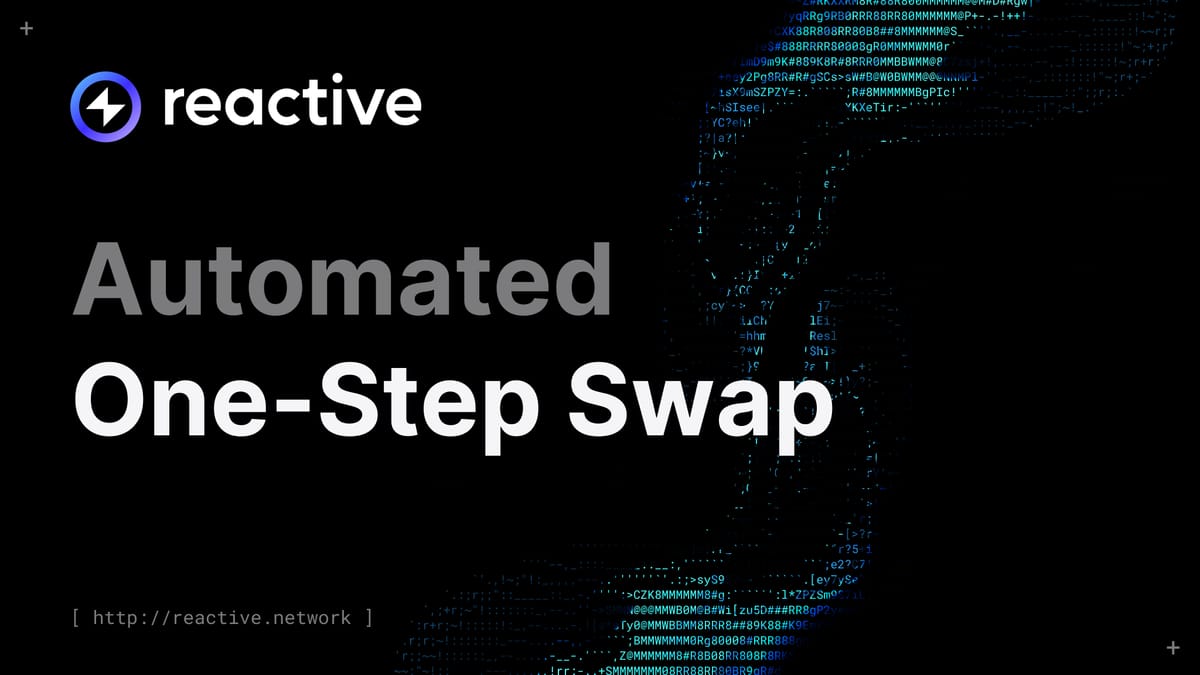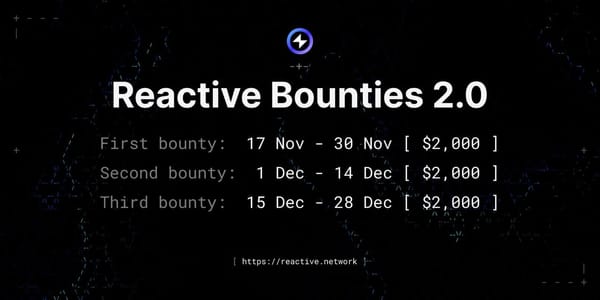Automated One-Step Swap
This article elaborates on how RSCs implement an automated one-step swap, transforming the way users interact with DEXes.

Token swaps on decentralized exchanges (DEXes) have traditionally required multiple user actions, making the process cumbersome and time-consuming. However, with the appearance of Reactive Smart Contracts (RSCs), we can improve the user experience by reducing this process to a single user-signed transaction, with Reactive automatically handling the second transaction. This article elaborates on how RSCs implement an automated one-step swap, transforming the way users interact with DEXes.
Traditional Two-Step Swap
In the current landscape, completing a token swap on DEXes requires two user-signed transactions: approving a token for trading and executing the swap. This process is illustrated in the following diagram and is explained below:
The first Ethereum/Polygon/BNB/etc. network transaction, represented by arrow 1, involves the user approving the token for the DEX to spend. The second transaction, represented by arrows 2, 3, and 4, involves the user executing the swap.
Here’s a detailed breakdown of the process:
First user-signed transaction:
- Arrow 1 – The user with the `0xBD7...5C` address calls the `approve()` method on the ERC-20 Token A contract. This action allows the DEX Pool Smart Contract to spend the user's Token A later.
Second user-signed transaction:
- Arrow 2 – The user initiates the swap by calling the `swap()` method on the DEX Pool SC.
- Arrow 3 – The DEX Pool SC calls the `tokenA.transferFrom` method, which transfers ERC-20 Token A from the user to the DEX Pool SC.
- Arrow 4 – The DEX Pool SC calls the `tokenB.transferFrom` method, transferring ERC-20 Token B to the user and completing the process.
This is how the process currently looks. Some exchanges have even changed the name of the button in their interface to “Approve & Swap” to make it clearer for the user. However, they still require the user to sign several transactions for this single swap in their wallet, which is far from an ideal user experience.
Reactive One-Step Swap
With Reactive Smart Contracts (RSCs) being a true game changer, we can transform the whole process and simplify it to just one user-signed transaction, with Reactive automatically handling the second transaction. Here’s a diagram to show how it works:
In this scheme, arrow 1 represents the first Ethereum (or Polygon, BNB, etc.) transaction, which is signed by the user. Arrow 2 is the Reactive transaction on the Reactive Network. Arrows 3, 4, 5, and 6 represent the second transaction on the Ethereum network, which is signed by the Reactive Network. Let us look at this process in detail.
The first Ethereum transaction signed by the user:
- Arrow 1 – The user with the `0xBD7...5C` address clicks the “Approve & Swap” button in the DEX interface and approves Token A for the Reactive Network to spend by calling the `approve()` method on the ERC-20 Token A contract. This forms the one and only user-signed transaction.
The Reactive transaction:
- Arrow 2 – The Reactive Smart Contract (Reactive SC) detects the `Approval` event and triggers the `react()` method. As a result, it emits the `Callback` event.
The second Ethereum transaction signed by Reactive:
- Arrow 3 – The `Callback` event triggers the `callback()` method on the Callback Smart Contract (Callback SC).
- Arrow 4 – The Callback SC calls the `tokenA.transferFrom` method, which transfers ERC-20 Token A from the user to the Callback SC.
- Arrow 5 – The Callback SC executes the swap by calling the `swap()` method on the DEX Pool SC.
- Arrow 6 – The Callback SC calls the `tokenB.transferFrom` method, transferring ERC-20 Token B to the user. This forms the second transaction signed by Reactive, finalizing the process.
This is how Reactive Smart Contracts automate the “Approve & Swap” process. While the diagram may seem more complicated than the one for the traditional workflow, the actual complexity is taken from the user and handled automatically. For the user, it’s a single transaction they sign, with the rest occurring on its own.
Conclusion
Reactive Smart Contracts (RSCs) simplify the traditional token swap process on decentralized exchanges (DEXes) by consolidating the approval and swap steps into a single user-signed transaction. This approach reduces complexity, making the process more accessible and efficient for newcomers. By lowering the threshold level for entry and minimizing user actions, RSCs enhance overall platform efficiency and have the potential to attract more users and increase the flow of funds into DEXes, driving the growth of decentralized finance.
Join our Hackathon and bounty program today to start building with Reactive Smart Contracts and bring your innovative ideas to life on the Reactive Network!
About Reactive Network
The Reactive Network, pioneered by PARSIQ, ushers in a new wave of blockchain innovation through its Reactive Smart Contracts (RSCs). These advanced contracts can autonomously execute based on specific on-chain events, eliminating the need for off-chain computation and heralding a seamless cross-chain ecosystem vital for Web3’s growth.
Central to this breakthrough is the Inversion of Control (IoC) framework, which redefines smart contracts and decentralized applications (DApps) by imbuing them with unparalleled autonomy, efficiency, and interactivity. By marrying RSCs with IoC, Reactive Network is setting the stage for a transformative blockchain era, characterized by enhanced interoperability and the robust, user-friendly foundation Web3 demands.





